Why you can trust Tom's Hardware
Comparison Products
The Seagate Game Drive M.2 SSD for PS5, or Game Drive for short, would not have had a lot of competition when its controller first came out. Today though, there are a lot of different drives that work great in the PS5. At least it doesn’t have competition from PCIe 5.0 SSDs like the Gigabyte Aorus Gen5 12000 as these do not work well with the PS5 at this time. It’s also safe from PCIe 3.0 SSDS like the Samsung 980, as the PS5 requires a base level of performance.
We consider two of the best desktop SSDs to be the Solidigm P44 Pro, or similar SK hynix Platinum P41, and the WD Black SN850X. The venerable Samsung 980 Pro is showing its age but can make for a good bargain if you’re shooting for a lower cost per GB. The Game Drive’s most direct competitors have the same hardware, represented by the Sabrent Rocket 4 Plus-G and the PNY XLR8 CS3140. The former makes more sense for a Windows gaming computer, though, as it has DirectStorage-optimized firmware.
While SMI was a force to be reckoned with in terms of SSD controllers for Gen 3, the Gen 4 SM2264 was late to arrive. It performs well enough - see the ADATA legend 960 and Transcend 250H reviews - but doesn’t particularly impress. A more significant rival would be the MAP1602, as it’s paired with YMTC TLC that has been very affordable at the 4TB point, if maximum storage is your goal. Our first taste of this was with the Acer Predator GM7 .
Trace Testing: 3DMark Storage Benchmark
Built for gamers, 3DMark’s Storage Benchmark focuses on real-world gaming performance. Each round in this benchmark stresses storage based on gaming activities including loading games, saving progress, installing game files, and recording gameplay video streams. Future gaming benchmarks will be DirectStorage-inclusive and we include details of that where possible.
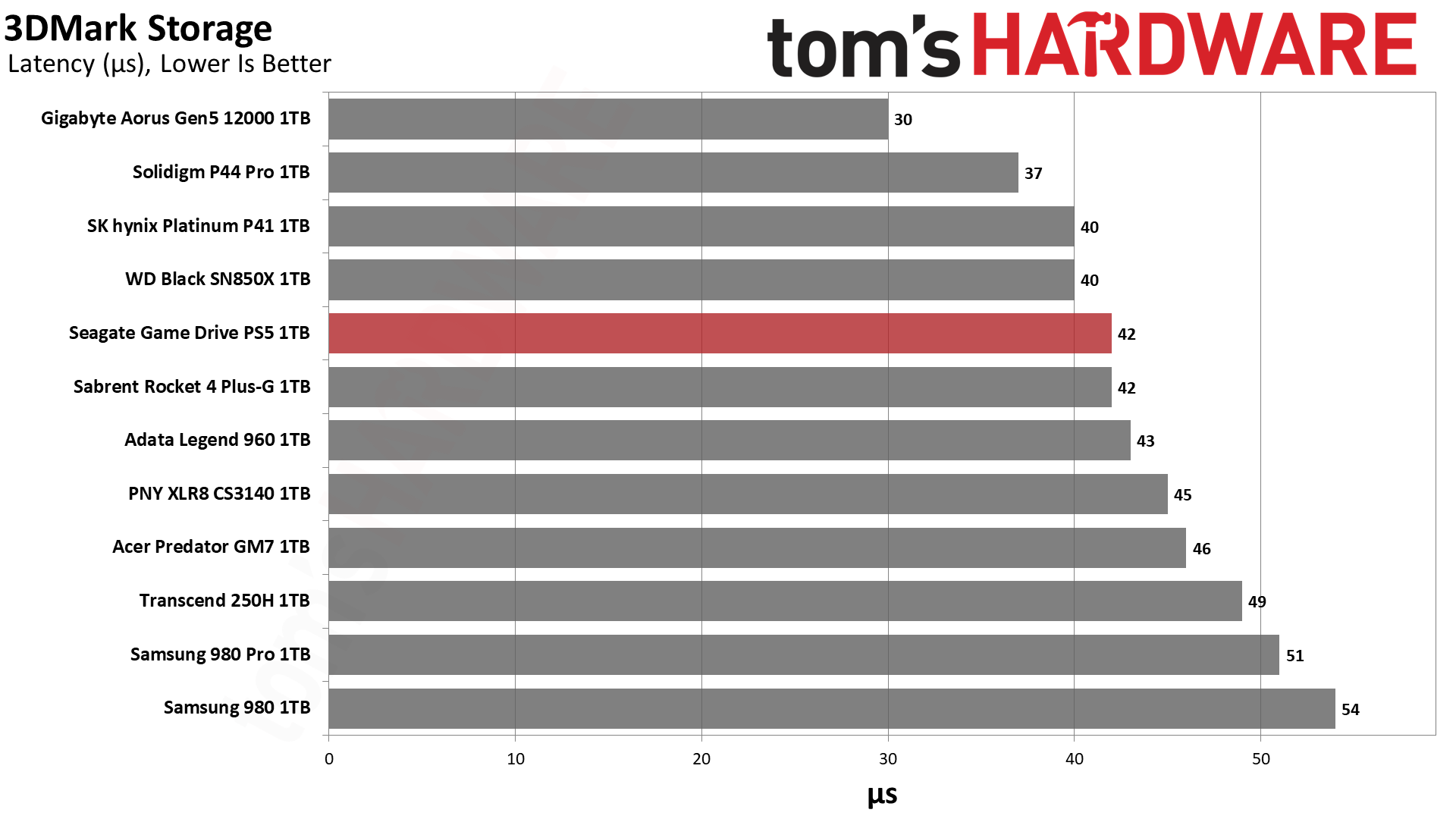


The Game Drive is good but not great in 3DMark. Frankly, though, we think it provides a great experience for gaming on a PC or a PS5. Game load times can be impacted on some scale by drive selection, but the difference on the PS5 is usually extremely small. The gap can open up for some games on PC but it’s rarely enough to matter.
That said, this chart does help illuminate some of the performance differences between these drives. The 250H and Legend 960, for example, differ only in their flash. The BiCS5 on the 250H makes for a notably slower result. While that flash is often celebrated for its speed on the SN850X, it’s clear it’s not the fastest flash and is also less power-efficient. You can also see the massive gap in performance between Gen 3 and Gen 5 with the 980 and Aorus Gen5 12000.
Trace Testing: PCMark 10 Storage Benchmark
PCMark 10 is a trace-based benchmark that uses a wide-ranging set of real-world traces from popular applications and everyday tasks to measure the performance of storage devices.
Get Tom's Hardware's best news and in-depth reviews, straight to your inbox.
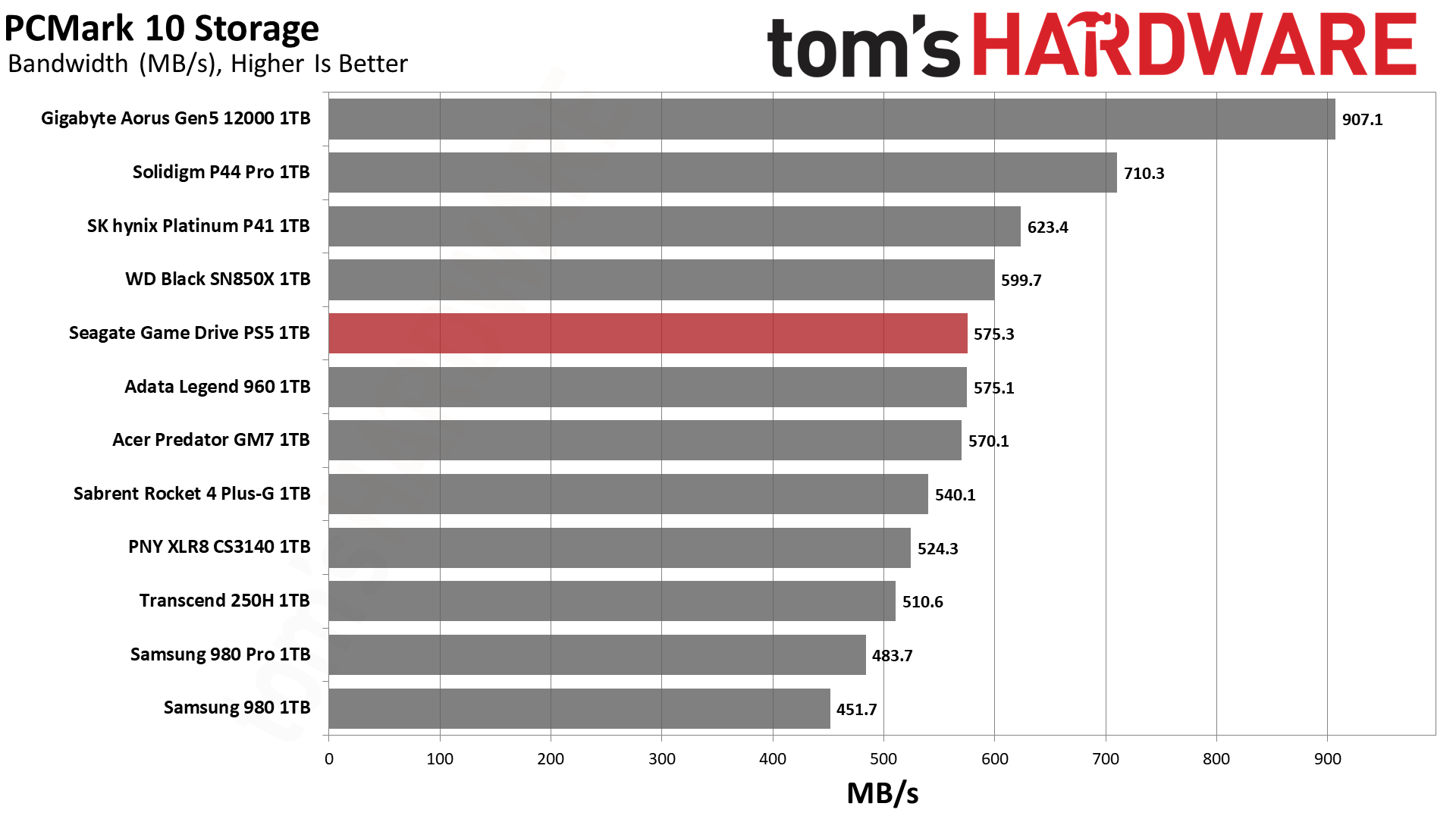
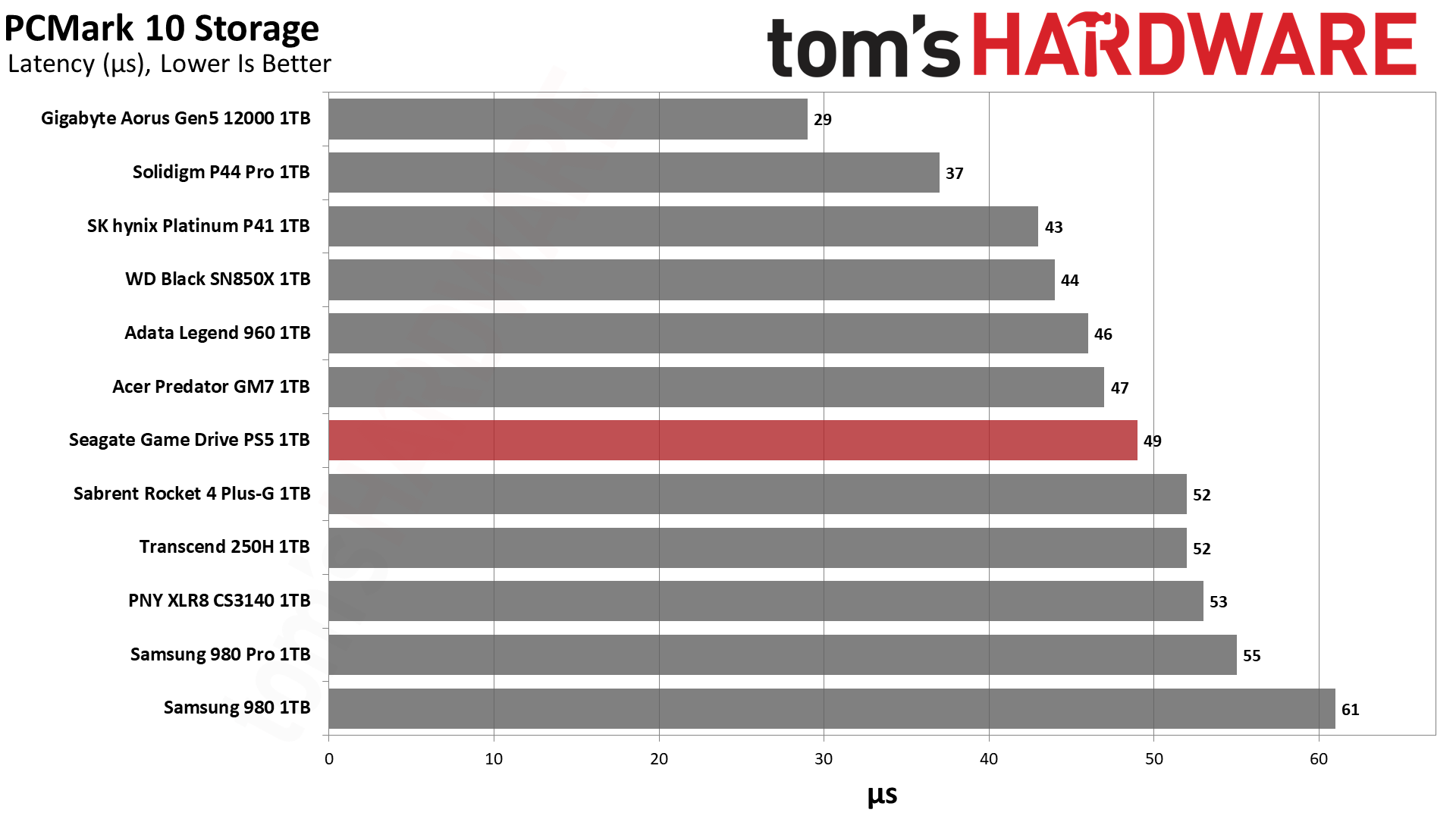
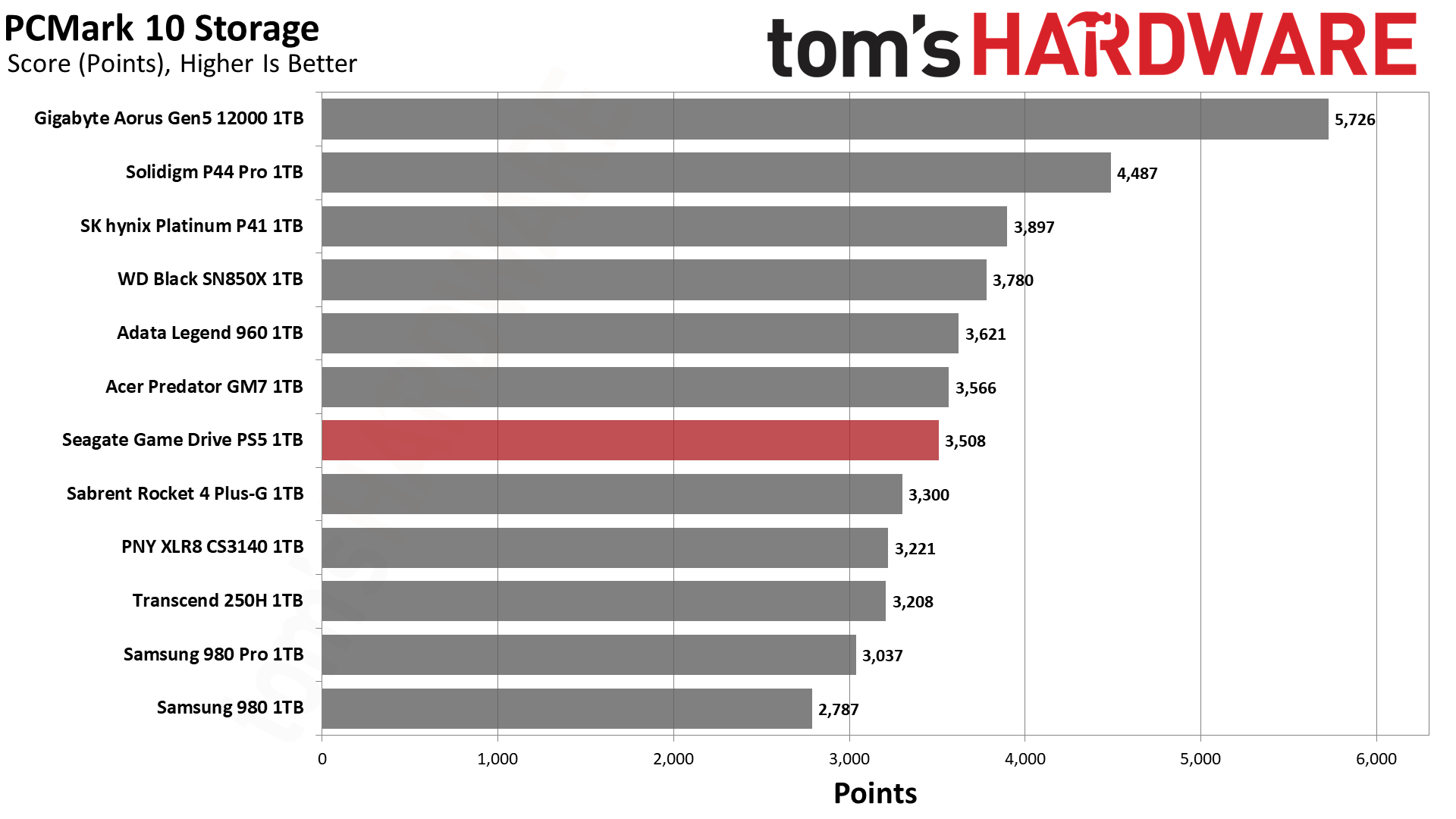
The Game Drive doesn’t quite keep up as well in PCMark 10. The Legend 960 and Predator GM7, in particular, demonstrate the ability for other controllers to keep up with the E18. The 250H with its BiCS5 falls behind again, and the Aorus Gen5 12000 doubles the bandwidth of the Gen 3 Samsung 980.
Console Testing: PlayStation 5 Transfers
The PlayStation 5 is capable of taking one additional PCIe 4.0 or faster SSD for extra game storage, with some requirements. Launch models could not take 8TB drives but this limit has since been removed. While any 4.0 drive will work, Sony specifies drives that can deliver at least 5,500 MB/s of sequential read bandwidth are optimal. The PS5 does not support the host memory buffer (HMB) feature but DRAM-less drives will still work. In our testing, PCIe 5.0 SSDs performed irregularly and should not be used in the PS5, especially as they may require additional cooling. Please see our Best PS5 SSDs article for more information.
Our testing utilizes the PS5’s internal storage test and manual read/write tests with over 192GB of data both from and to the internal storage. Throttling is prevented where possible to see how each drive operates under ideal conditions.
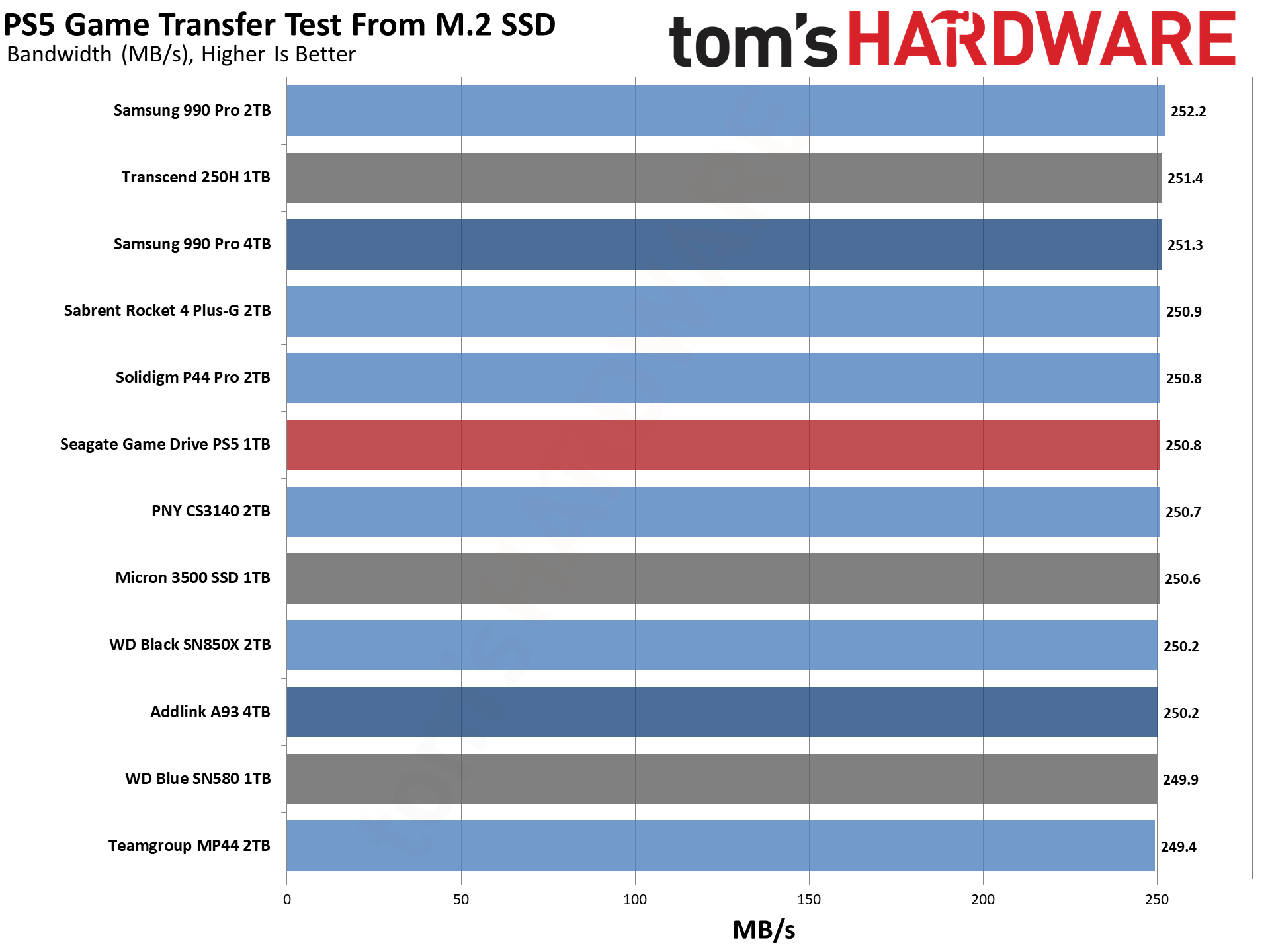


Aside from slower Gen 4 drives like the WD Blue SN580, there’s not a lot of difference between one drive and another when it comes to PS5 performance. The Micron 3500, which is the OEM version of the Crucial T500, scores a little weak here, but Micron has been testing PS5 performance for future firmware optimization on both drives.
Transfer Rates: DiskBench
We use the DiskBench storage benchmarking tool to test file transfer performance with a custom, 50GB dataset. We copy 31,227 files of various types, such as pictures, PDFs, and videos to a new folder and then follow-up with a reading test of a newly-written 6.5GB zip file. This is a real world type workload that fits into the cache of most drives.
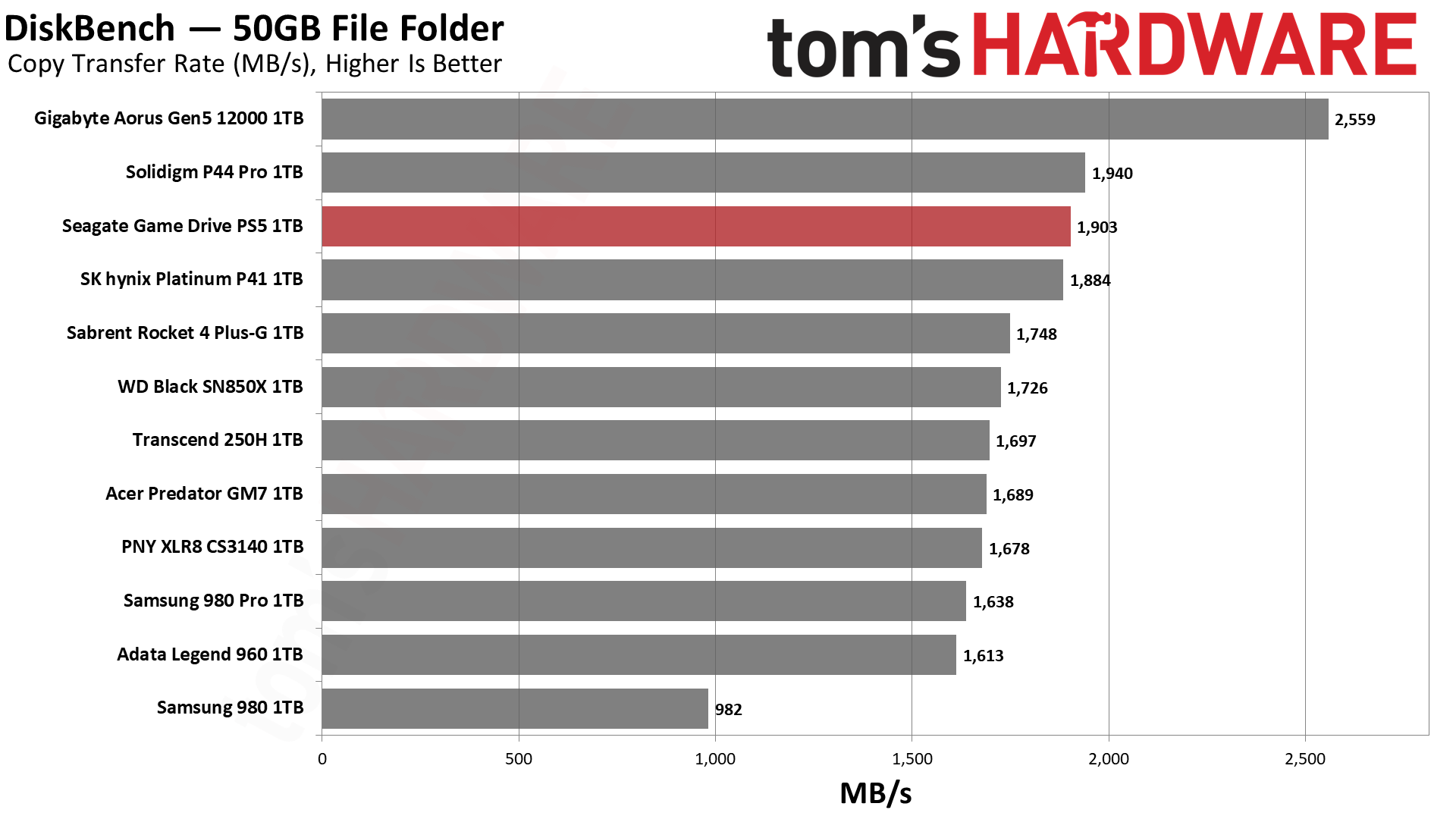

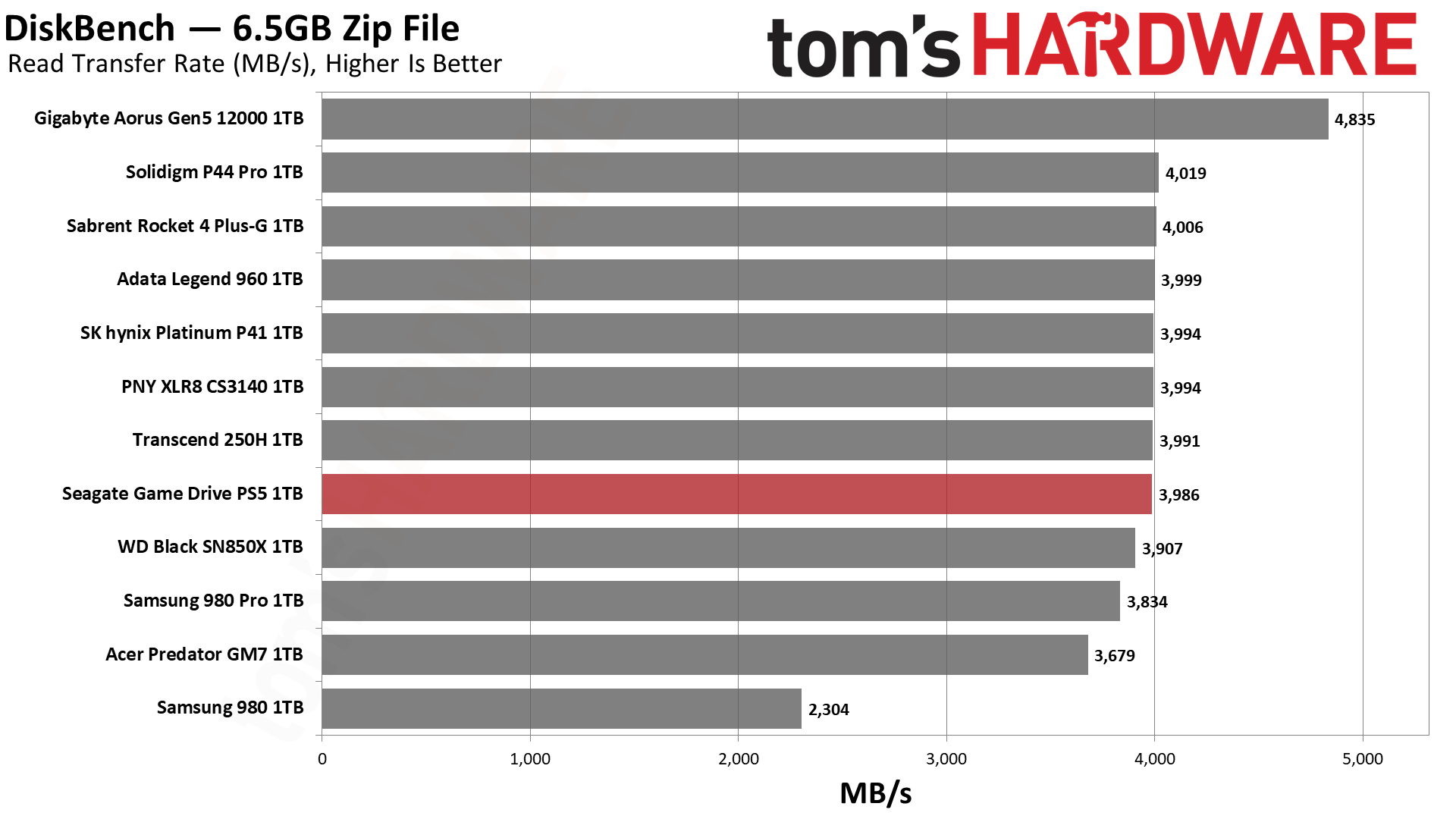
The Game Drive has very good transfer results thanks to its conservative cache design, shared with the FireCuda 530 and some other E18 SSDs such as the Rocket 4 Plus-G. The Aorus Gen5 12000 doesn’t pull away as much as you would expect as the Gen 5 drives need at least 2TB of flash to reach high levels of performance. For that matter, many of the drives listed perform better at 2TB, and we would recommend that capacity as the current sweet spot. Gen 3 SSDs like the 980 have trouble keeping up with newer technology and higher bandwidth.
Synthetic Testing: ATTO / CrystalDiskMark
ATTO and CrystalDiskMark (CDM) are free and easy-to-use storage benchmarking tools that SSD vendors commonly use to assign performance specifications to their products. Both of these tools give us insight into how each device handles different file sizes and at different queue depths.
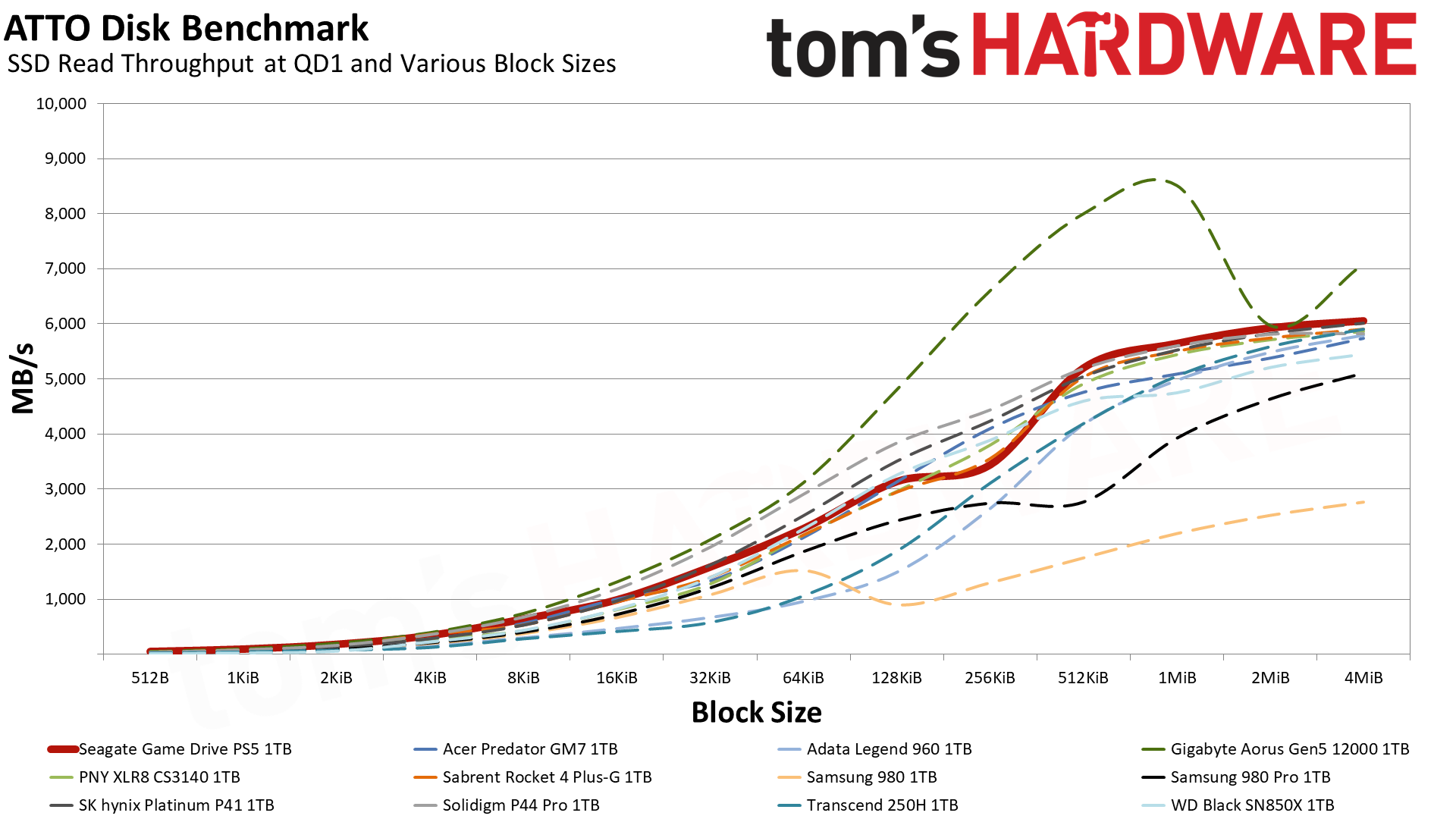

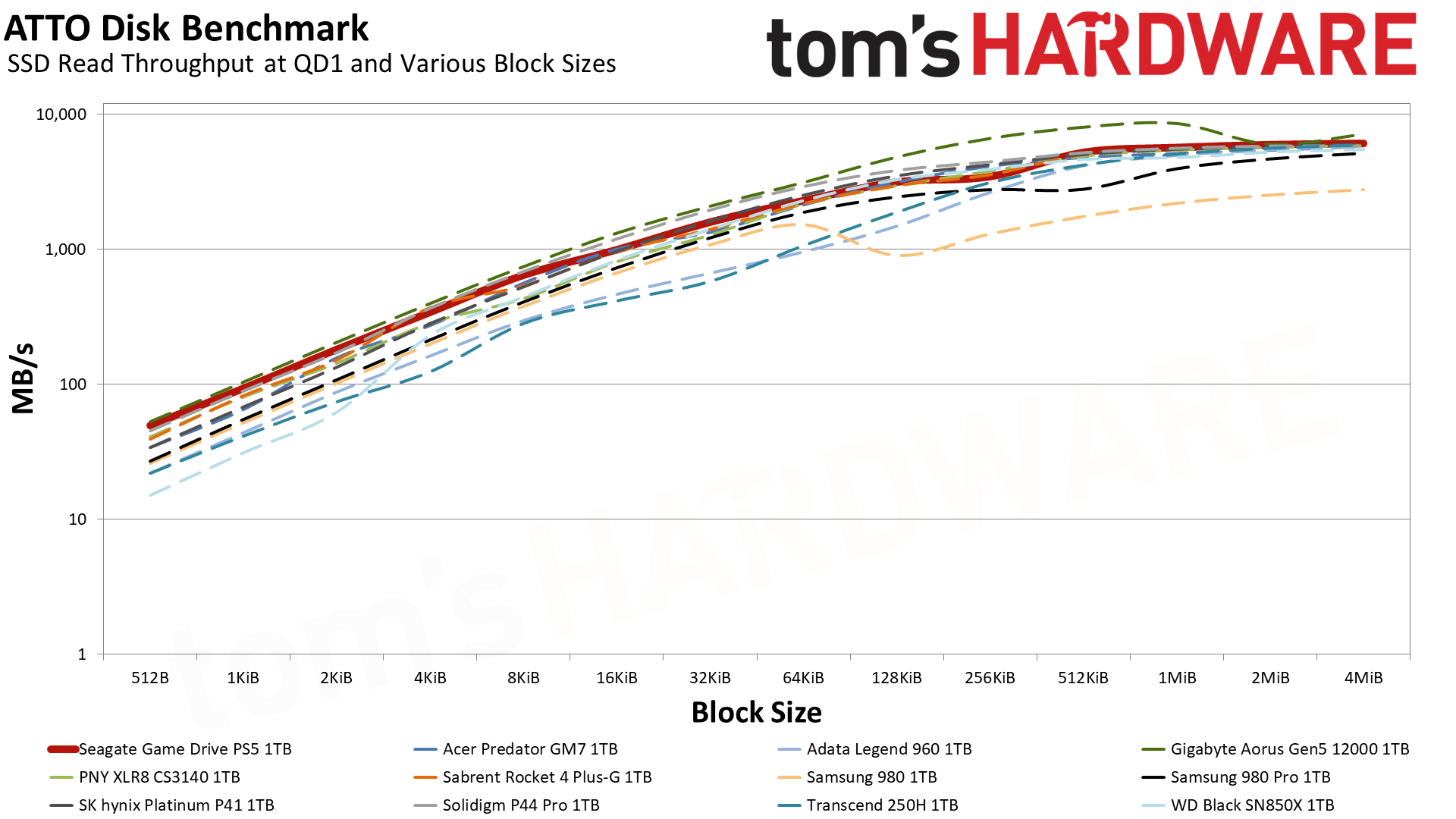

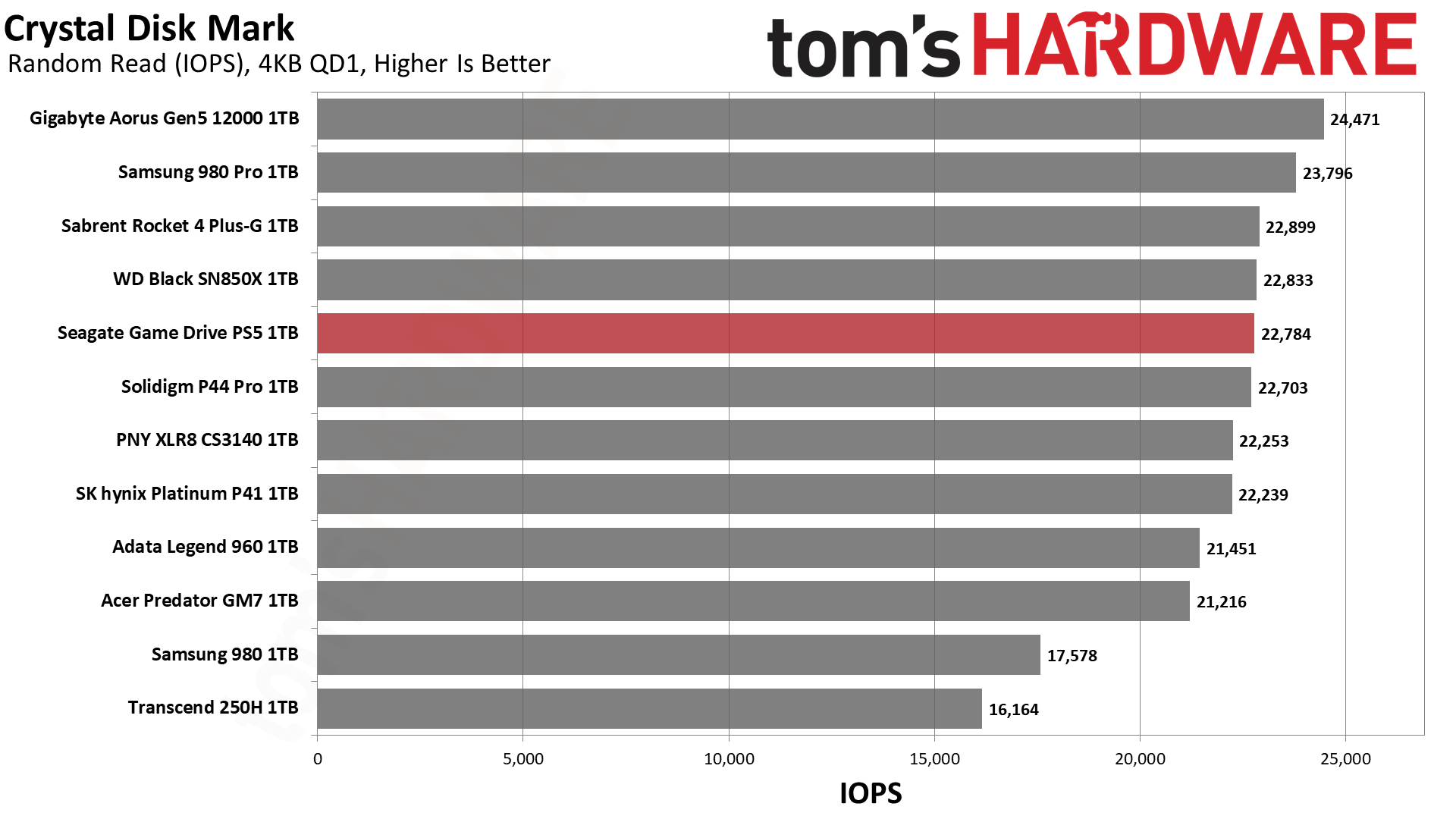
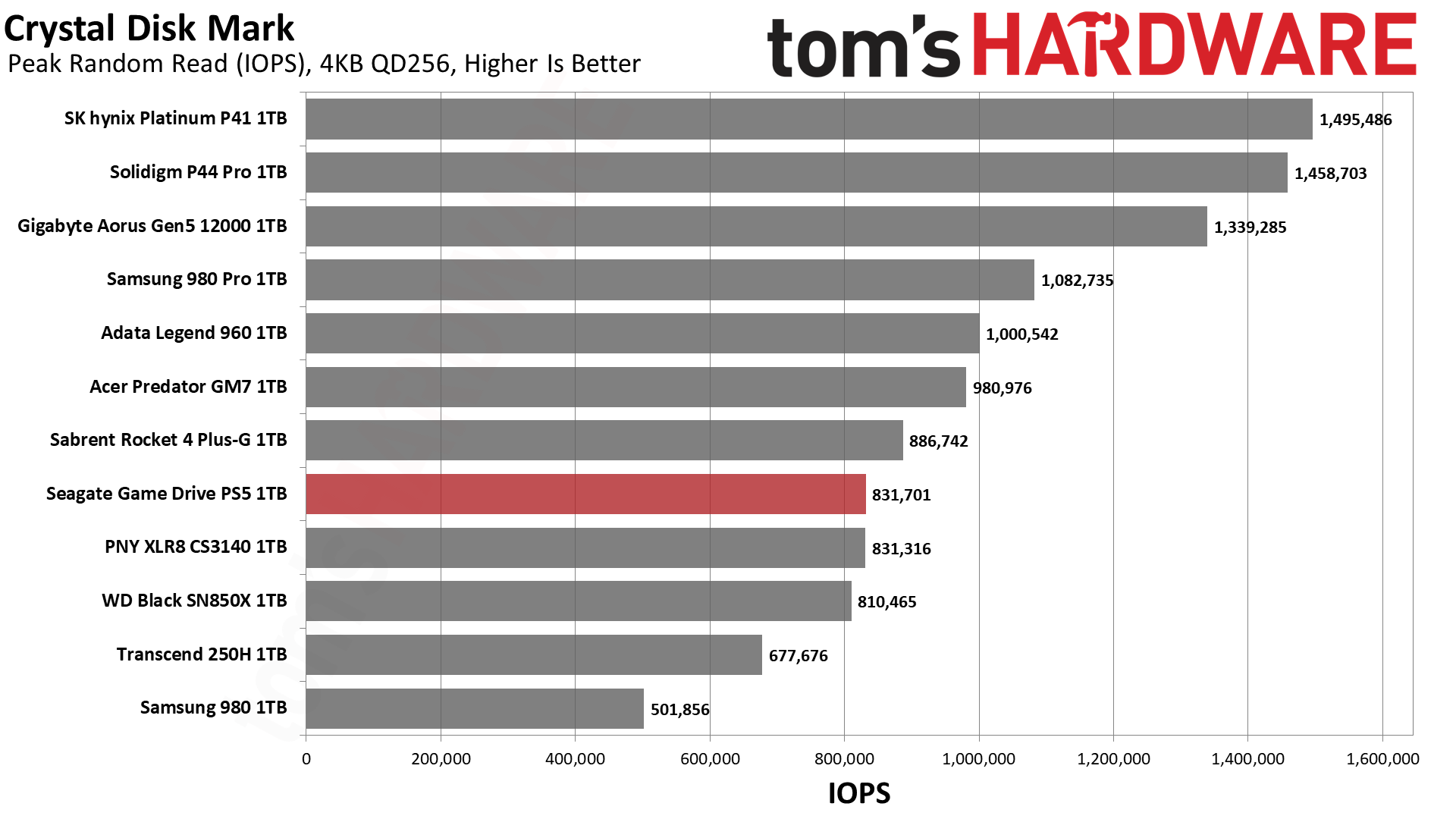

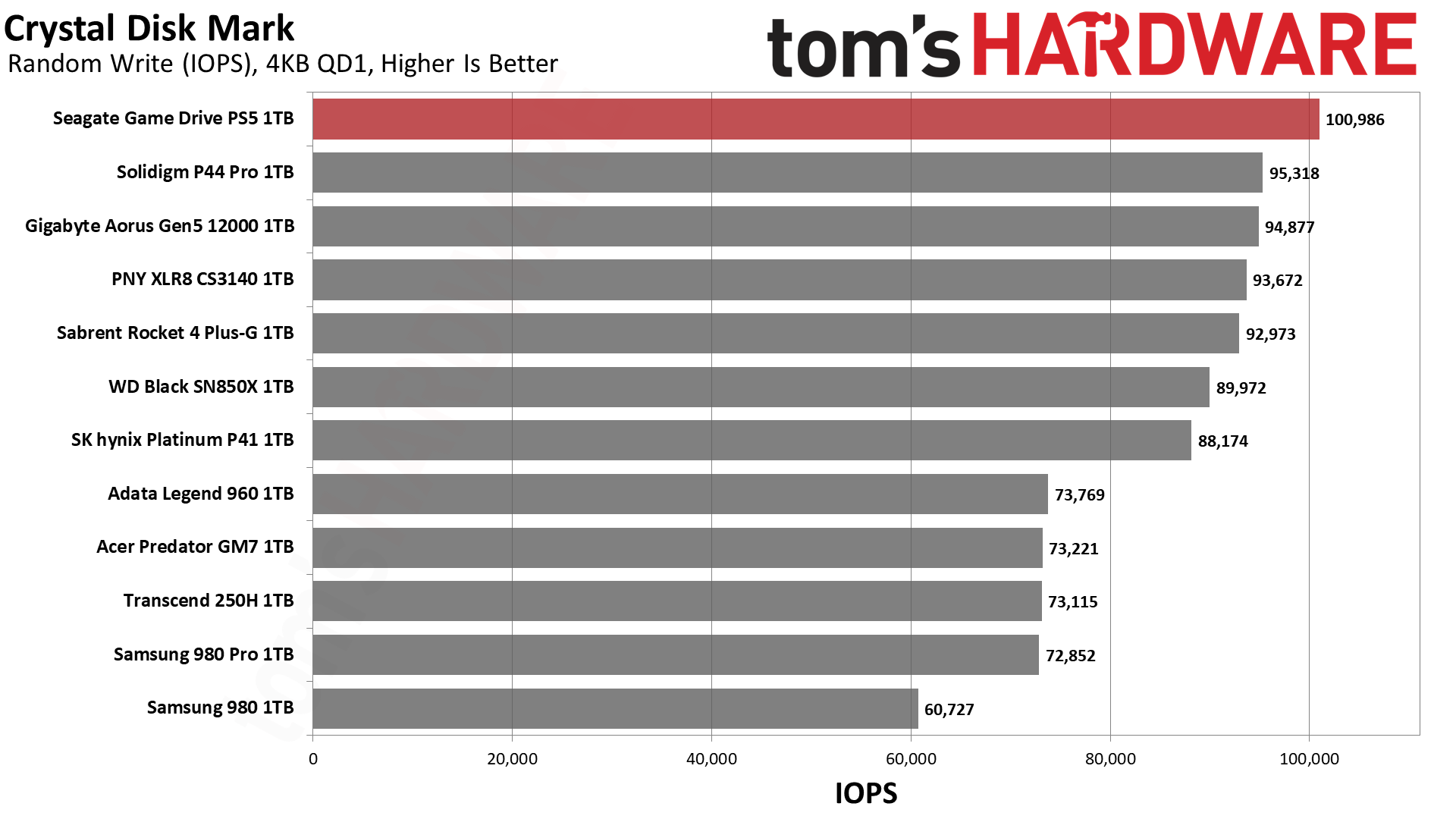
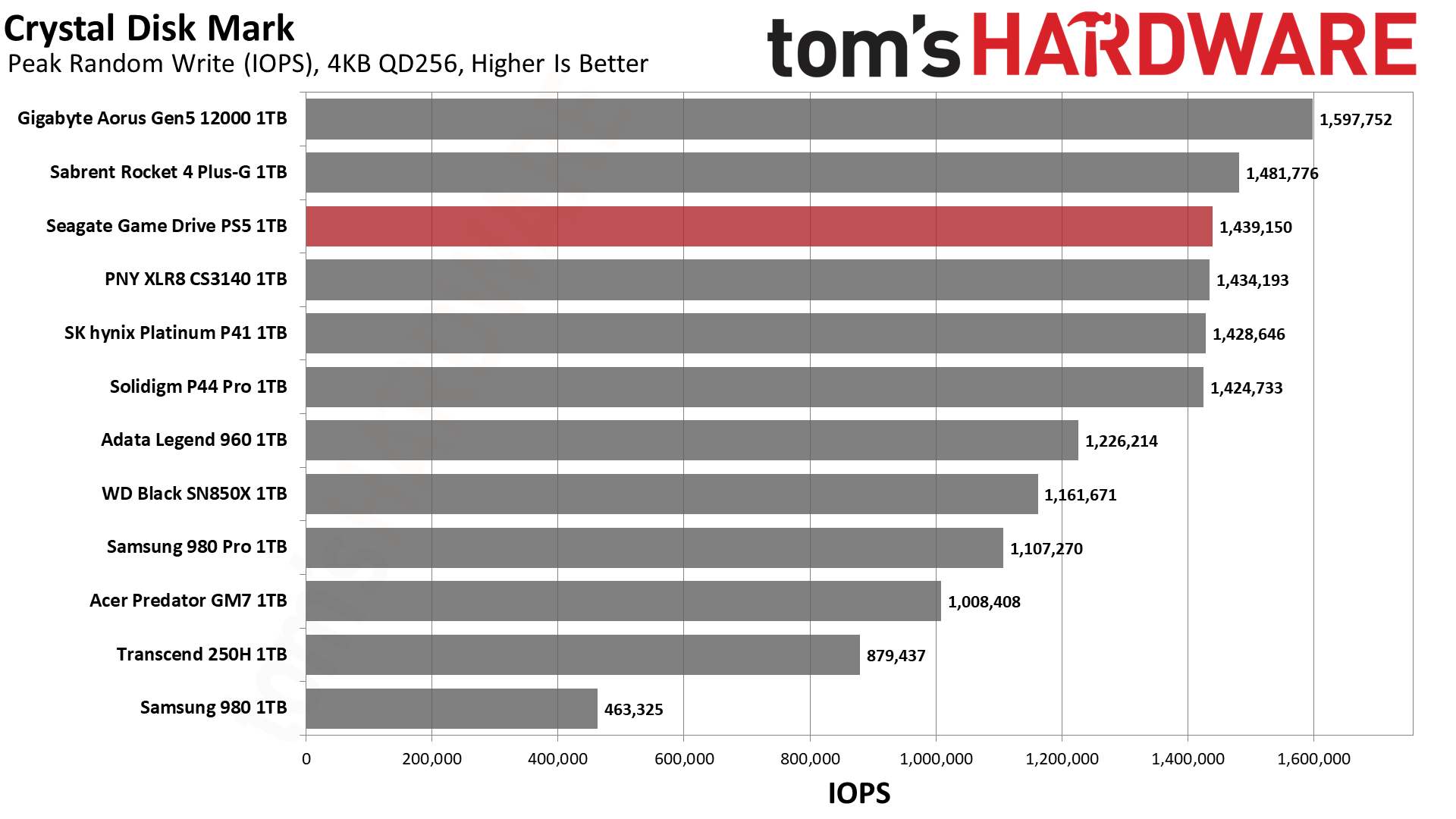
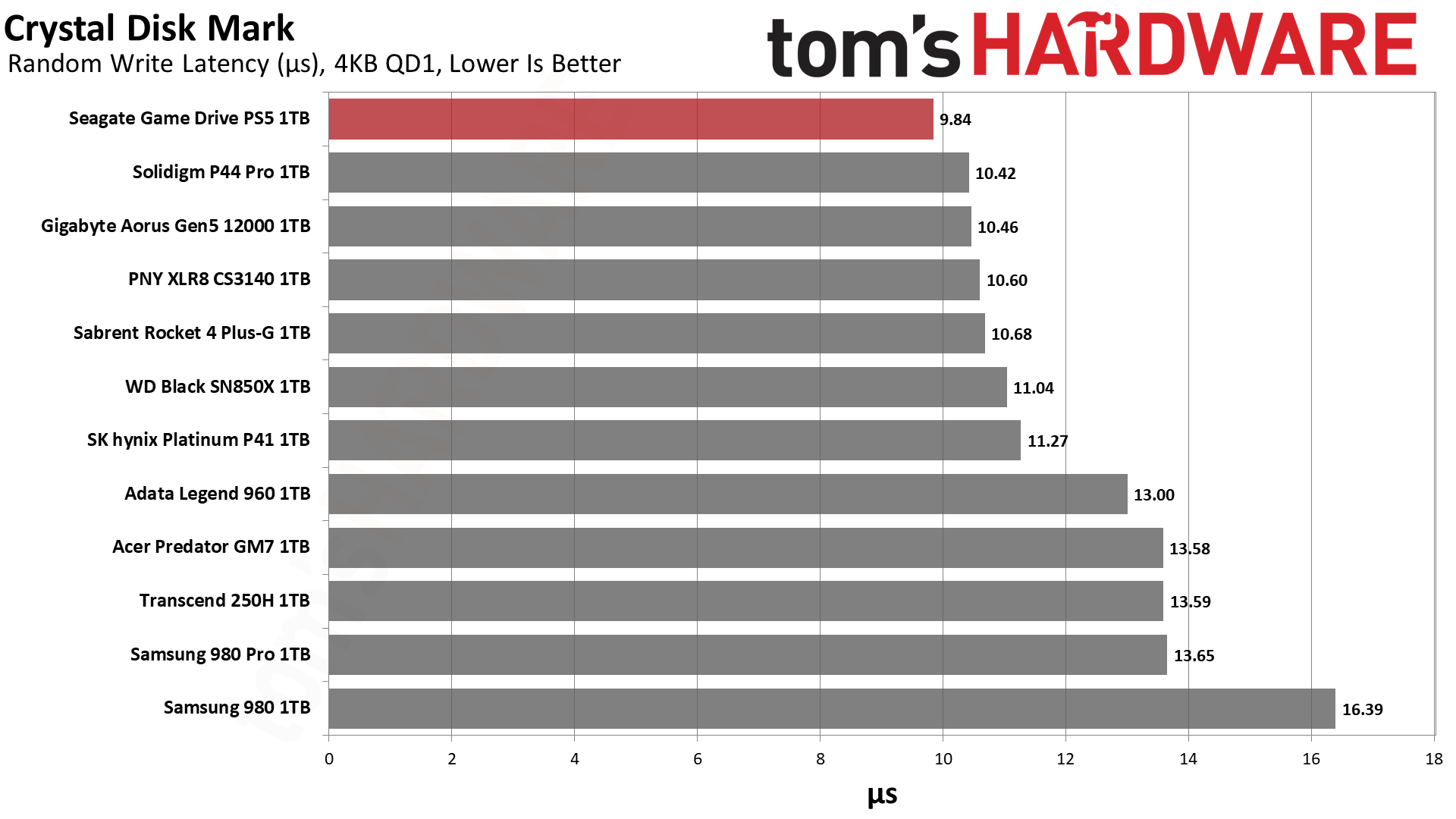
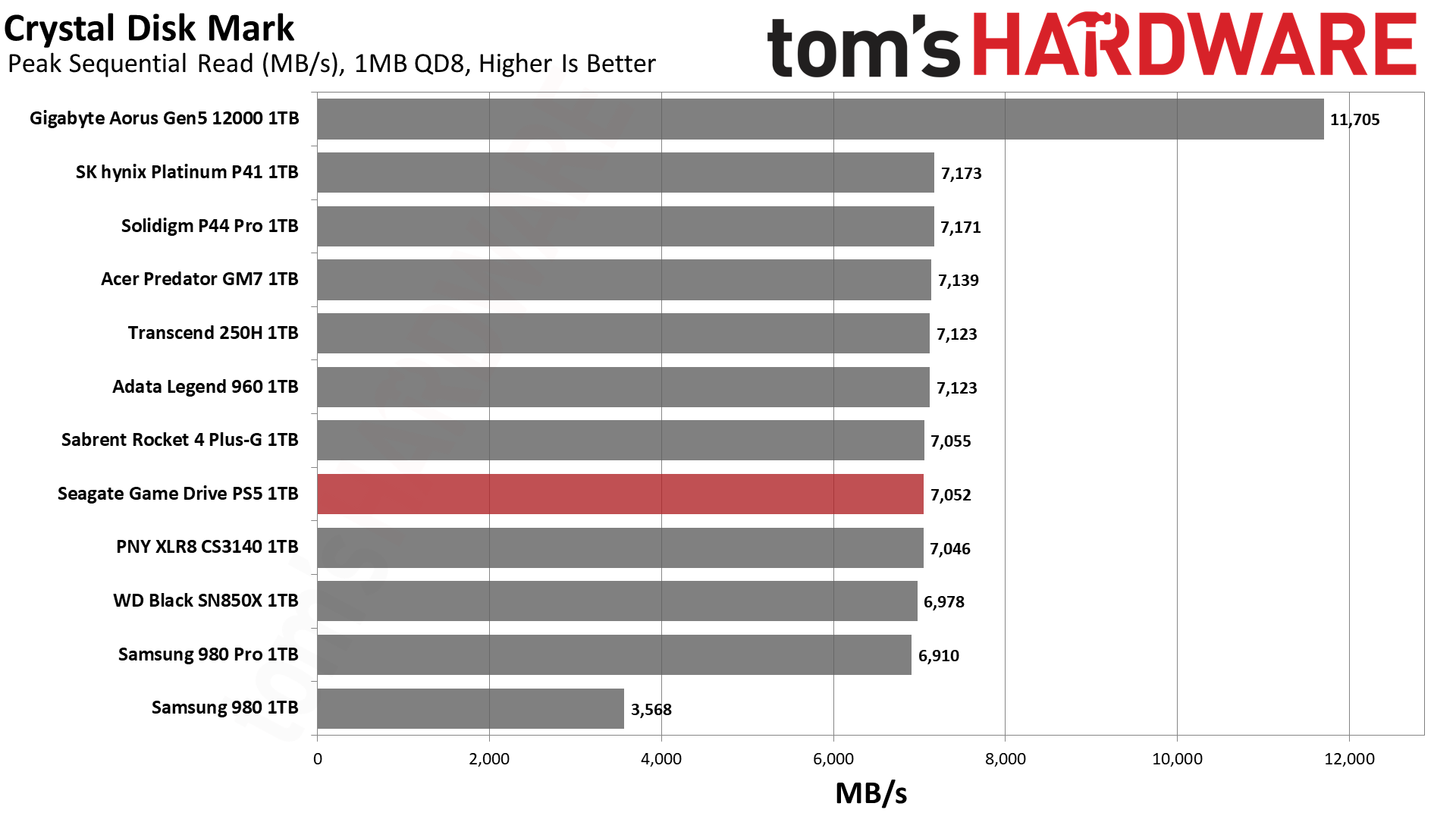
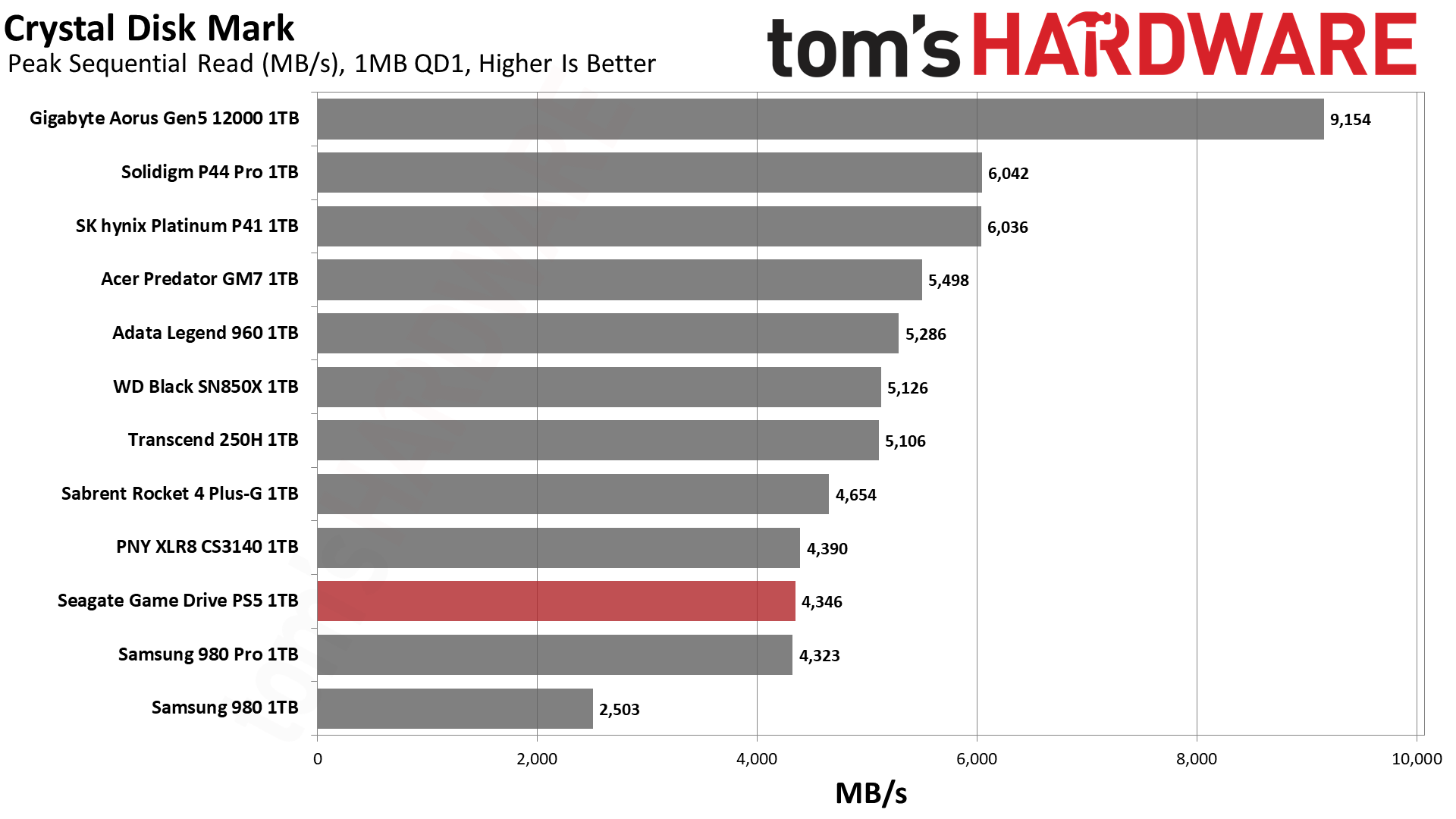
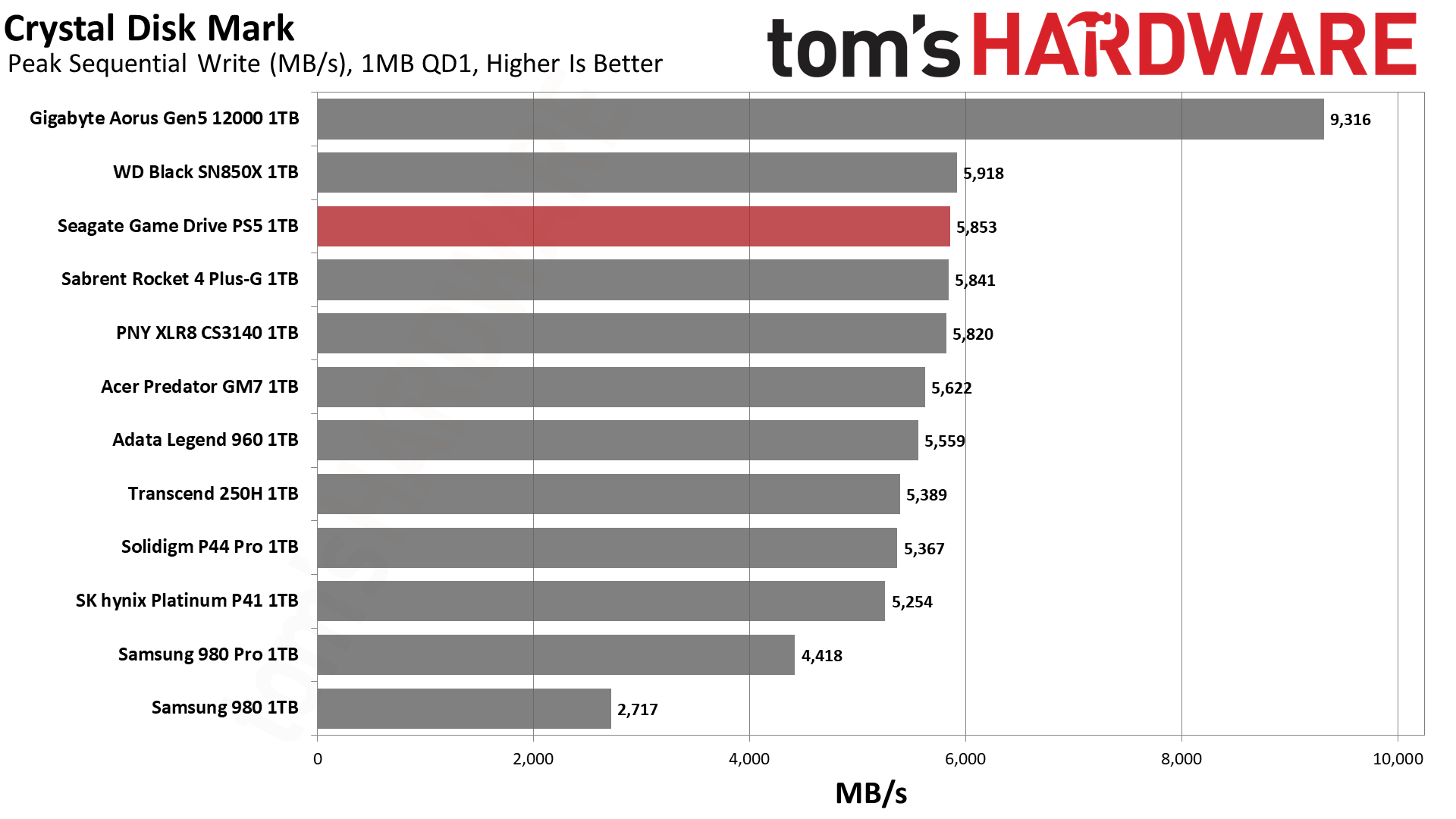
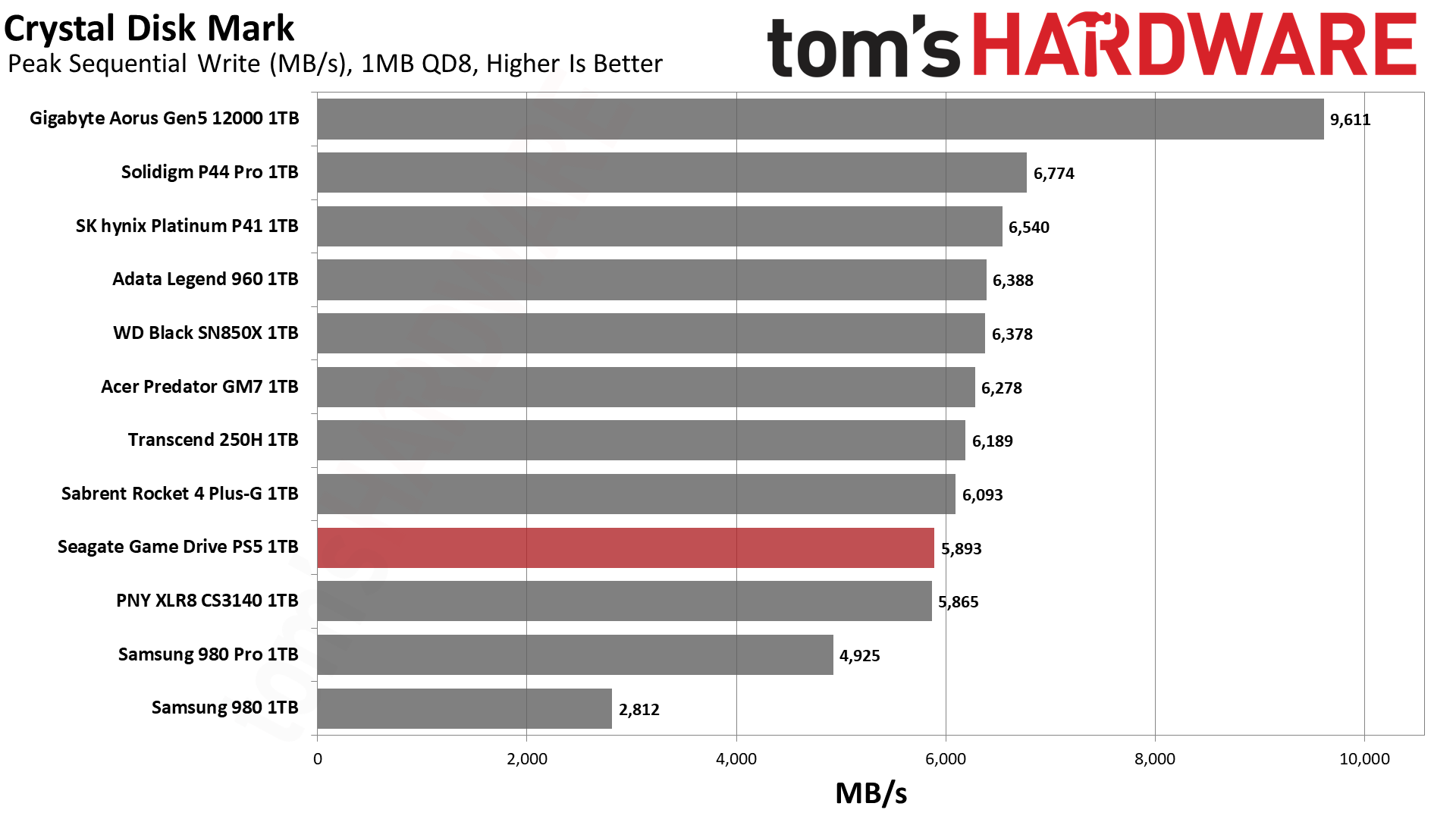
We have no complaints with the Game Drive’s sequential performance, but the hardware is starting to age. Many drives have better QD1 sequential reads and QD8 sequential writes, plus the drive’s high QD random read IOPS show that newer controllers pack in a lot of horsepower. Even the DRAM-less, four-channel MAP1602 on the GM7 has a strong showing. But QD1 random latencies are still the most important, and the Game Drive manages to do quite well for itself in those two tests.
Sustained Write Performance and Cache Recovery
Official write specifications are only part of the performance picture. Most SSDs implement a write cache, which is a fast area of (usually) pseudo-SLC programmed flash that absorbs incoming data. Sustained write speeds can suffer tremendously once the workload spills outside of the cache and into the "native" TLC or QLC flash.
We use Iometer to hammer the SSD with sequential writes for 15 minutes to measure both the size of the write cache and performance after the cache is saturated. We also monitor cache recovery via multiple idle rounds. This process shows the performance of the drive in various states as well as the steady state write performance.
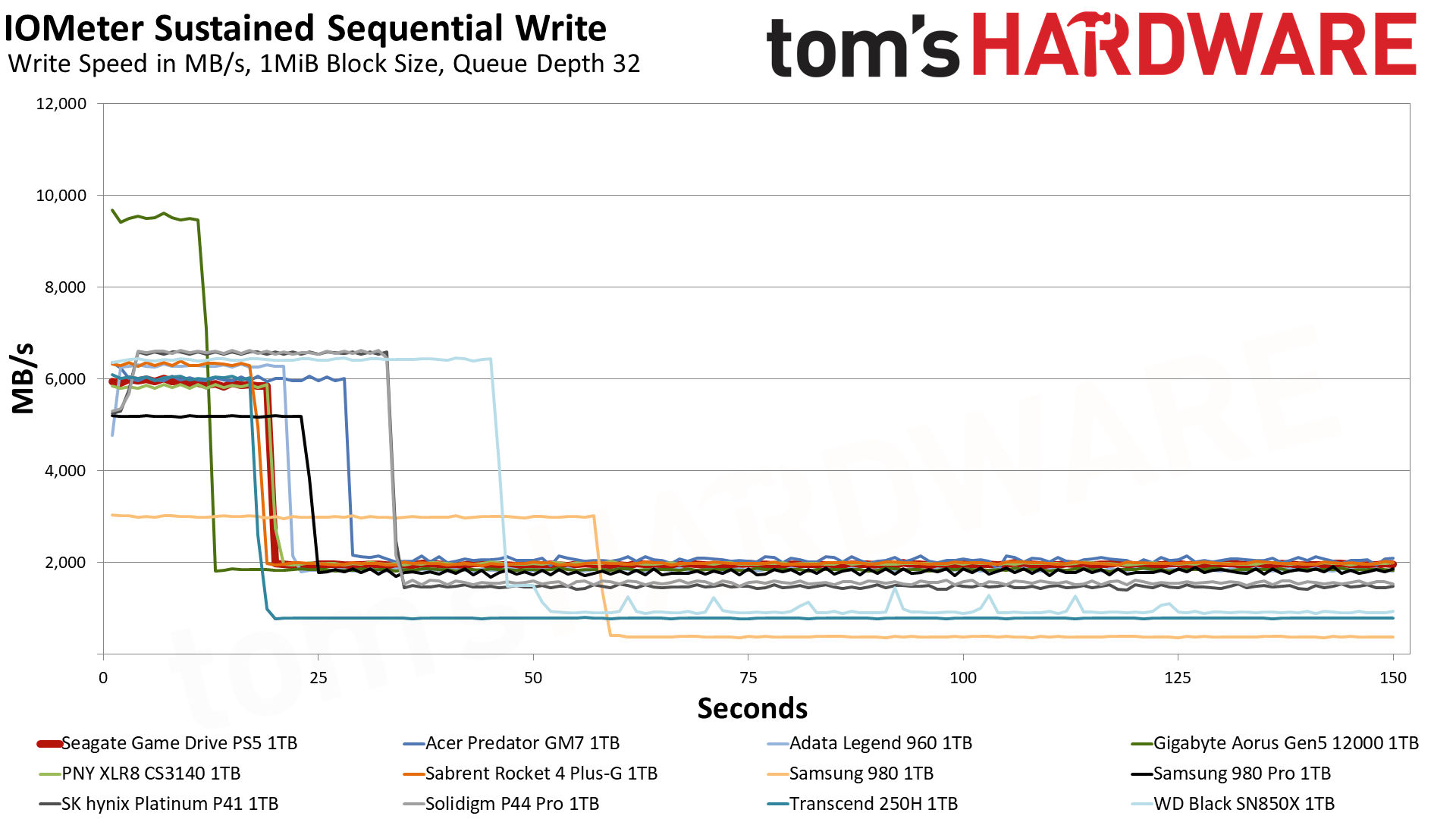
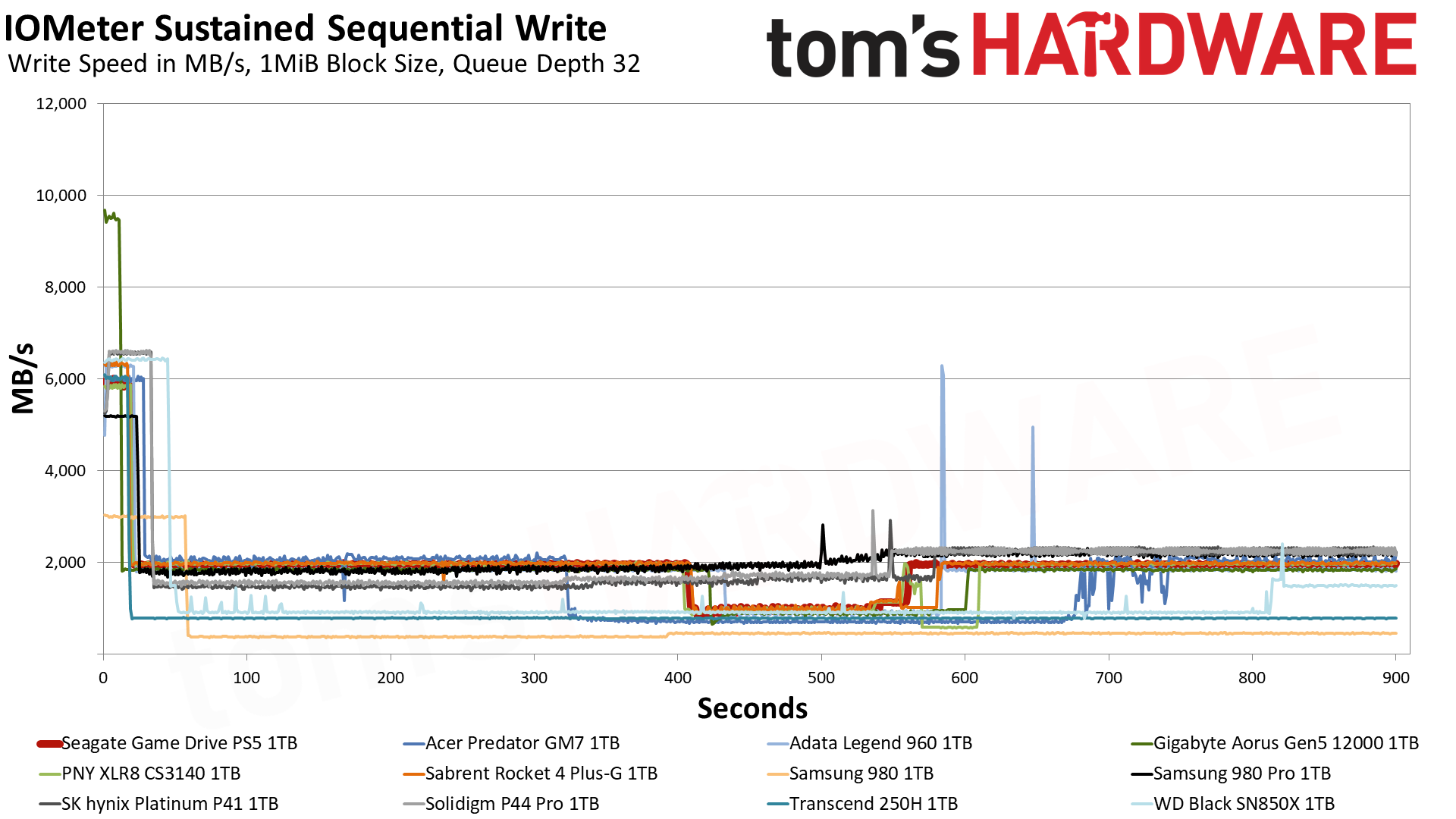

The 1TB Game Drive writes in pSLC at an average speed of just above 5.9 GB/s for under 20 seconds. This cache is around 112GB, which is ample in size. It then hits TLC mode at around 1.95 GB/s with steady state performance to match. Performance can be maintained for quite some time, but if the drive is forced to fold it drops down to about 940 MB/s with background recovery. This result is quite good for a 1TB drive and is more than powerful enough for any PS5 workload.
Power Consumption and Temperature
We use the Quarch HD Programmable Power Module to gain a deeper understanding of power characteristics. Idle power consumption is an important aspect to consider, especially if you're looking for a laptop upgrade as even the best ultrabooks can have mediocre stock storage. Desktops may be more performance-oriented with less support for power-saving features, so we show the worst-case.
Some SSDs can consume watts of power at idle while better-suited ones sip just milliwatts. Average workload power consumption and max consumption are two other aspects of power consumption but performance-per-watt, or efficiency, is more important. A drive might consume more power during any given workload, but accomplishing a task faster allows the drive to drop into an idle state more quickly, ultimately saving energy.
For temperature recording we currently poll the drive’s primary composite sensor during testing with a 24C ambient. Our testing is rigorous enough to heat the drive to a realistic ceiling temperature.



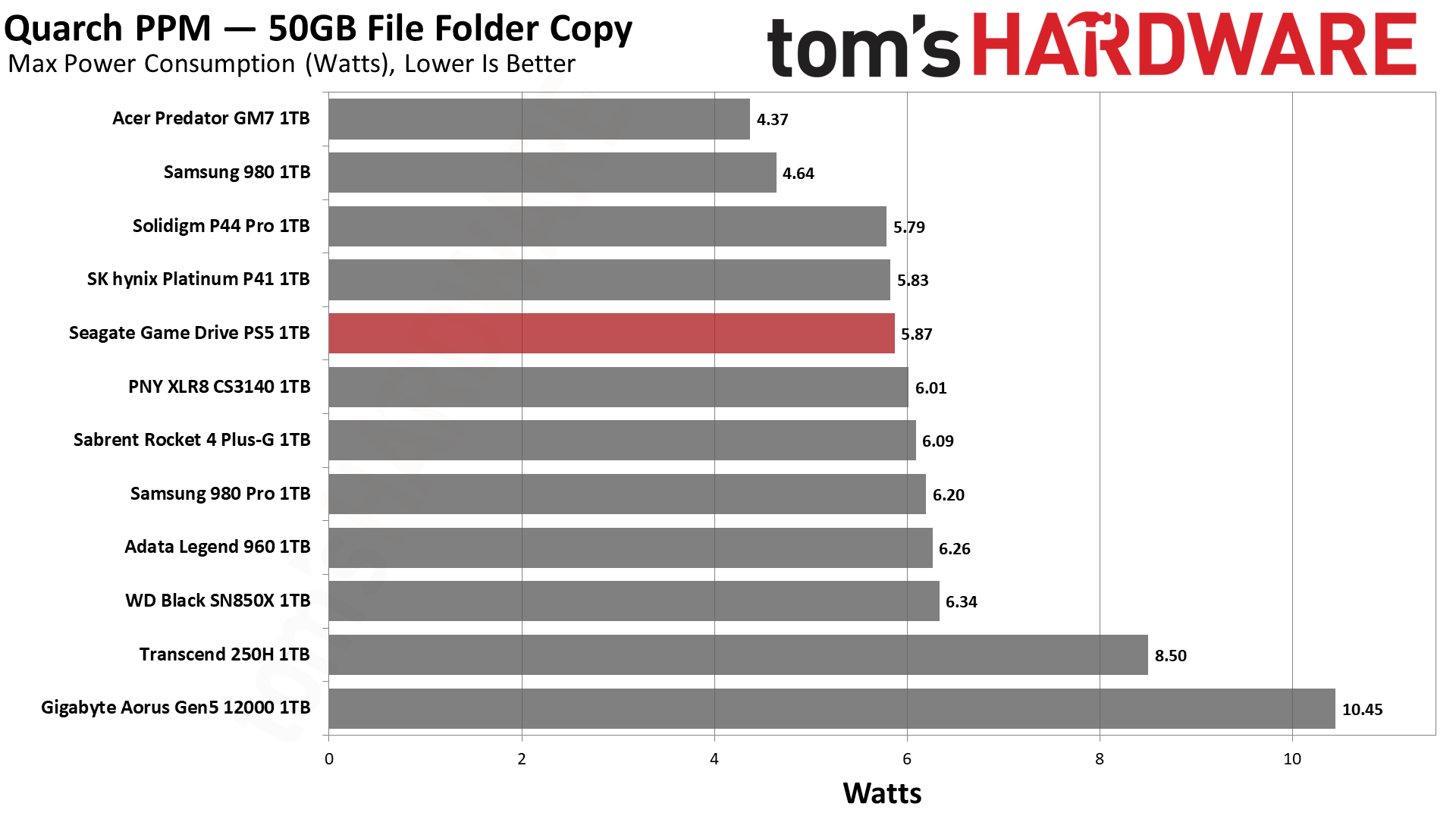
The Game Drive is relatively efficient, but it trails behind some of the better Gen 4 options. It’s also nowhere near the DRAM-less MAP1602 on the GM7. The Lexar NM790 and Addlink A93 score similarly and have heatsink options to make it a strong competitor to the Game Drive, especially at 4TB. The 1TB Game Drive is rated for 6.3W average load, 20-30mW in low-power PS3, and <5mW for idle L1.2, by datasheet. The SMART reading is only slightly off with 6.4W for load, but our maximum power consumption was read to be lower than this. Idle power in a system with proper power management will be significantly less than what we measured.
We had absolutely no problems with throttling on this drive. The heatsink is more than adequate. By SMART, the throttling states are at 90°C and 95°C, but it’s probably best to keep drives under 80°C. This drive is not designed for laptops but will work in a desktop PC and should stay sufficiently cool with its included heatsink.
Test Bench and Testing Notes
| CPU | Intel Core i9-12900K |
| Motherboard | Asus ROG Maximus Z790 Hero |
| Memory | 2x16GB G.Skill DDR5-5600 CL28 |
| Graphics | Intel Iris Xe UHD Graphics 770 |
| CPU Cooling | Enermax Aquafusion 240 |
| Case | Cooler Master TD500 Mesh V2 |
| Power Supply | Cooler Master V850 i Gold |
| OS Storage | Sabrent Rocket 4 Plus 2TB |
| Operating System | Windows 11 Pro |
We use an Alder Lake platform with most background applications such as indexing, Windows updates, and anti-virus disabled in the OS to reduce run-to-run variability. Each SSD is prefilled to 50% capacity and tested as a secondary device. Unless noted, we use active cooling for all SSDs.
Bottom Line
We have nothing bad to say about the Seagate Game Drive M.2 SSD for PS5, but there’s also little that makes it stand out, given its marketing. You don’t need a special drive for the console. The heatsink is effective and Seagate’s warranty is generous with its write endurance, but neither of these are make-or-break factors. You can add your own after-market heatsink and there’s no way you’ll be committing that many writes in a PS5. On the other hand, the sustained performance is quite good and this drive could end up used for other things, in which case it’s not the worst choice.
Some enthusiasts will point out that this drive is essentially the same as many competitor drives. This is a valid criticism, although we can tell Seagate has put some effort toward building consistent and reliable drives. Nevertheless, there’s no getting around the fact that the Game Drive is the same as the heatsinked version of the FireCuda 530. This isn’t a bad thing, but it does mean you’ll want to avoid paying more as a “PS5 tax” when considering this drive over others.
If we depart from the long list of drives that use the same hardware as the Game Drive we can paint a better picture of the competition. Faster drives like the SN850X, P44 Pro, and Samsung 990 Pro don’t offer much substance over it. The newer T500 would be a good pick, but there’s no 4TB option available yet. Instead, DRAM-less drives with YMTC flash like the NM790, A93, and Patriot Viper VP4300 Lite are popular and affordable at that capacity. This puts the Game Drive in a tough spot, although we think its use of mature hardware is in its favor.
If you’re looking for a solid PS5 SSD, Seagate’s Game Drive is a good choice. We can wholly recommend it but suggest you decide on a capacity before buying. Right now, it’s best at 2TB, while there are other good options at 4TB. You could also go with a standard drive at 1TB to save some money. At 2TB, things are a bit murkier, but it’s certainly possible to get a well-performing drive for the PS5 - with or without heatsink - at or below the Game Drive’s price. You should factor in your impressions of Seagate when buying, but if you want something reliable and flexible this drive is far from the worst impulse purchase option.
MORE: Best Hard Drives
MORE: Best SSDs
MORE: How We Test HDDs And SSDs

Shane Downing is a Freelance Reviewer for Tom’s Hardware US, covering consumer storage hardware.
